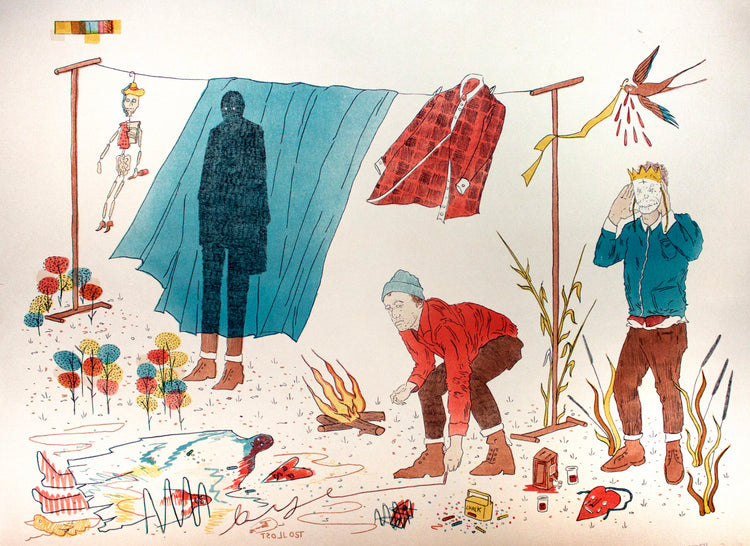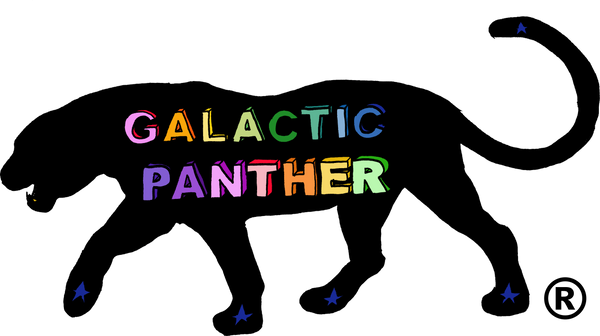Collection: Highways & Haunts Exhibit
Artist Statement:
My work uses the lithographic process to create narrative prints which combine Americana imagery with that of myth and legend. The prints deal with the emptiness of the American landscape, the derivation of ghost stories and local legends, objects of Art History, and the culture surrounding the highway system. The prints also explore how time can move within a single visual space, similar to the way hieroglyphs exist as a contained image, but can be read in the same fashion as words on a page. Objects and foliage appear scattered along the ground, as if a tornado whipped through a gas station and a history museum and all artifacts landed together in the same field.
The prints can be read as a series of visual ghost stories, each, in part, exploring the theme of the nature colliding with human made spaces, like a deer bursting through the windshield of a car. Nature in this case, isn’t just the idea of foliage, animals, or wide open landscapes, but also the presence of death. Deer along the side of the highway manifest this ghostly symbol. Their eyes illuminate headlights at night, driving in the dark, you can just barely make out their form in your peripheral as you speed by. Plus, it seems more common that we see deer dead than alive, lying on the side of the road from where they came, victims of our cars and freeways.
Through out the works, ghosts are also personified as geese crashing into a bathroom window, a figure with mismatched socks under a sheet, as well as mysterious footsteps in the snow, walking away from someone who’s slipped beneath the ice. They are an exploration of the uneasy feeling of the unknown, not just the cliche of not feeling alone in a dark room, but also the excitement and anxiety of entering an unfamiliar building, landscape, town etc.
In his study of Kentucky folklore, “Ghosts Along the Cumberland” William Montell describes a farm worker who claims to have come across the ghost of a cow he had put down the previous week. He sees it in the field, goes to get his family, and when they return, the cow is gone. That’s the end of the story. I think the works have a similar sense of "ghost story”. It isn’t really any kind of cautionary tale, but more a study of the moment between someone in their day to day life experiencing the absurd, in whatever form. Then, when they try and share it with someone else, that thing is gone.

-
The Camping Trip | Emmett Merrill
Regular price $400.00 USDRegular priceUnit price / per -
The Girl in the Shadow Box | Emmett Merrill
Regular price $400.00 USDRegular priceUnit price / per -
Doppelgänger 1 | Emmett Merrill
Regular price $350.00 USDRegular priceUnit price / per -
Billowing Smoke | Emmett Merrill
Regular price $400.00 USDRegular priceUnit price / per -
The Long Boring End | Emmett Merrill
Regular price $500.00 USDRegular priceUnit price / per -
Laocoon | Emmett Merrill
Regular price $400.00 USDRegular priceUnit price / per -
New Years Eve | Emmett Merrill
Regular price $350.00 USDRegular priceUnit price / per -
Eulogy | Emmett Merrill
Regular price $400.00 USDRegular priceUnit price / per -
Salome | Emmett Merrill
Regular price $400.00 USDRegular priceUnit price / per -
 Sold out
Sold outChalk Drawings | Emmett Merrill
Regular price $200.00 USDRegular priceUnit price / per -
70 West | Emmett Merrill
Regular price $500.00 USDRegular priceUnit price / per -
Its a Drag, Such a Drag | Emmett Merrill
Regular price $400.00 USDRegular priceUnit price / per -
Western Motel | Emmett Merrill
Regular price $400.00 USDRegular priceUnit price / per -
Old Man | Emmett Merrill
Regular price $400.00 USDRegular priceUnit price / per -
Goodbye | Emmett Merrill
Regular price $350.00 USDRegular priceUnit price / per -
Birds of Paradise | Emmett Merrill
Regular price $400.00 USDRegular priceUnit price / per
















